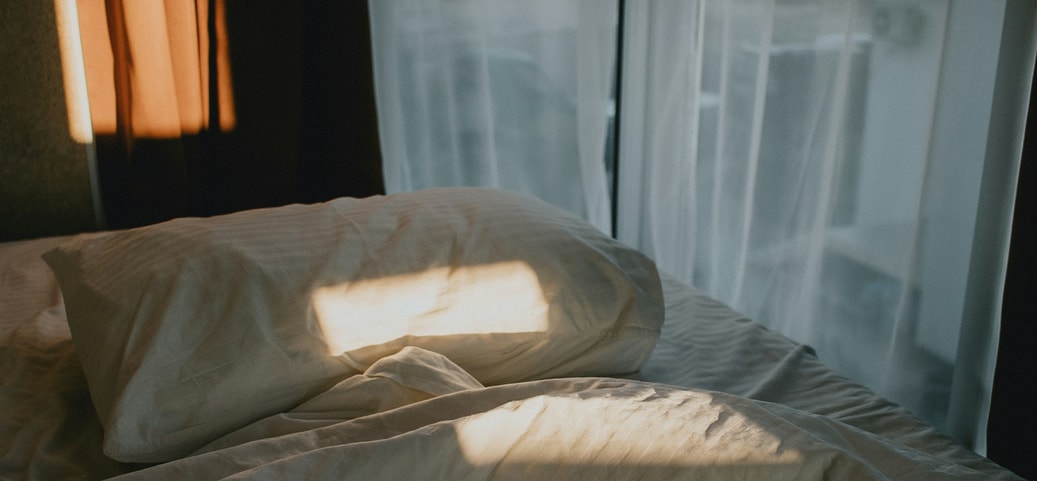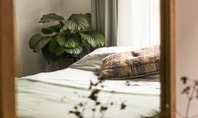The first night after the move: can’t sleep in your new apartment?
Moving into a new home begins a new – often long-awaited – chapter. However, if the first night starts with sleep problems, our romantic imaginings are quickly tarnished. But don’t worry, poor sleep after moving is not uncommon and even has a name – the ‘First Night Effect’! However, with our tips and a little patience, you’re sure to quickly get used to your new home.
by CALIDA
July 9, 2025•3 min reading time

New flat but no restful sleep? Tips for better sleep in an unfamiliar environment.
Table of Contents
What’s behind the ‘First Night Effect’?
• Make your first night in your new home more pleasant
How to feel more comfortable in your new bedroom in the long term
• Tip 1: Arrange furniture in a similar way to your old home
• Tip 2: Minimalism in the bedroom
• Tip 3: The ideal sleeping environment
• Tip 4: Create cosy feel-good rituals
The key points
Many people sleep worse on the first night in a new flat. This phenomenon is called the ‘First Night Effect’.
Bad sleep is usually caused by unfamiliar surroundings: different lighting and room conditions, new sounds and the stress of moving house can unconsciously disrupt sleep.
Calming bedtime routines, a familiar arrangement of furniture and good sleep hygiene help you to get used to your new bedroom more quickly.
What’s behind the ‘First Night Effect’?
Scientists call it the ‘First Night Effect’: a kind of protective mechanism that causes our brain to remain in a kind of awake state when we sleep in a new environment. We sleep worse because we are not yet able to assess potential sources of danger, such as unfamiliar sounds, lights and smells. As a result, we wake up briefly yet repeatedly – sometimes without noticing and sometimes completely consciously.
Although this effect is unpleasant and can lead to tiredness and exhaustion the next day, it is completely normal – in fact, this phenomenon affects the vast majority of people. The good news is that the quicker your brain classifies your new environment as safe, the quicker your sleep will improve – and you can do a lot to help!
Make your first night in your new home more pleasant
Even small things can help alleviate sleep problems on the first night in your new home. For example, try to furnish your bedroom as early as possible – ideally before moving day. Also, avoid turning the bedroom into a storage room for moving boxes; clarity, minimalism and functionality are the key to restful sleep here.
In addition to a tidy and functional bedroom, you can use a sleep mask, earplugs and blackout curtains to block out light, noise and clutter. What’s more, wear comfortable sleepwear that makes you feel great all over; soft, smooth CALIDA pyjamas made from temperature-regulating TENCEL™ or SUPIMA®-cotton are the perfect choice. These materials adapt optimally to your body temperature and help you fall asleep in your new environment.
How to feel more comfortable in your new bedroom in the long term
Even after your first night in your new home, it may still take some time for you to fully settle in. This is also perfectly normal, as our sleep rhythm and sleep quality are strongly influenced by habit. So give your body the time it needs to adjust. You can make the adjustment easier with the following five tips:
Tip 1: Arrange furniture in a similar way to your old home
Humans are creatures of habit. Decorate your new bedroom in such a way that it reminds you of your previous home. You could put your bed and wardrobe in a similar place, use the same bedding, and place familiar items like lamps, books or a picture on the bedside table. All of this gives your subconscious orientation and security. Once you’ve got used to your new surroundings, you can gradually remove, replace or rearrange the old furniture and decorative elements.
Tip 2: Minimalism in the bedroom
When you’re just getting started in a new home, less is often more: avoid cluttered shelves or too many new furnishings. A minimalist design brings inner peace and ensures that your bedroom feels less overwhelming and strange.
Tip 3: The ideal sleeping environment
An ideal room temperature between 16°C and 18°C and good ventilation can significantly improve sleep quality. In addition, install dimmable or indirect light sources and avoid looking at screens before going to bed if possible, as blue light has been shown to impair melatonin production.
Tip 4: Create cosy feel-good rituals
Establish an evening routine that will relax you. It doesn’t matter whether you take a hot bath, have a cup of tea or read for 10 minutes in bed. The trick is that if you repeat these rituals every day, your brain automatically links them to falling asleep.
Tip 5: Choose the right mattress, bedding and pyjamas
If you sleep worse after the move, this may be due to an unsuitable mattress that does not support your body optimally. In addition, materials that don’t fit in with the season or simply feel scratchy and unpleasant also have an impact on sleep.
CALIDA’s sleepwear is made from breathable, snuggly soft fibres from natural origins such as TENCEL™ or organic cotton. This ensures optimal climate regulation – especially in a new environment which your body is not yet used to.
Conclusion
It’s not uncommon to have trouble sleeping on the first night in your new apartment or to feel poorly rested even after a few days. But there’s no need to worry: sleep problems after moving are usually only temporary and can be significantly improved with small adjustments. A calm and tidy sleeping environment, comfortable sleepwear and relaxing routines ensure that your body can settle down more quickly. Soon your new bedroom will become a true sanctuary where you can sleep well and recharge your batteries.
Discover more interesting blog posts:


